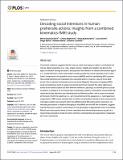Files in this item
Decoding social intentions in human prehensile actions : insights from a combined kinematics-fMRI study
Item metadata
| dc.contributor.author | Di Bono, Maria Grazia | |
| dc.contributor.author | Begliomini, Chiara | |
| dc.contributor.author | Budisavljevic, Sanja | |
| dc.contributor.author | Sartori, Luisa | |
| dc.contributor.author | Miotto, Diego | |
| dc.contributor.author | Motta, Raffaella | |
| dc.contributor.author | Castiello, Umberto | |
| dc.date.accessioned | 2020-06-25T11:30:07Z | |
| dc.date.available | 2020-06-25T11:30:07Z | |
| dc.date.issued | 2017-08-28 | |
| dc.identifier | 268624452 | |
| dc.identifier | 123ef75d-d1bd-4986-9e4e-0fa15b4978c4 | |
| dc.identifier | 85028536078 | |
| dc.identifier.citation | Di Bono , M G , Begliomini , C , Budisavljevic , S , Sartori , L , Miotto , D , Motta , R & Castiello , U 2017 , ' Decoding social intentions in human prehensile actions : insights from a combined kinematics-fMRI study ' , PLoS ONE , vol. 12 , no. 8 , e0184008 . https://doi.org/10.1371/journal.pone.0184008 | en |
| dc.identifier.issn | 1932-6203 | |
| dc.identifier.uri | https://hdl.handle.net/10023/20147 | |
| dc.description | Funding: This work was supported by a grant from the MIUR (N. 287713), the FP7: REWIRE project, by Progetto Strategico, Universitaà di Padova (N. 2010XPMFW4) to UC and by SIR grant (Scientific Independence of Young Researchers—N. RBSI141QKX) to LS. | en |
| dc.description.abstract | Consistent evidence suggests that the way we reach and grasp an object is modulated not only by object properties (e.g., size, shape, texture, fragility and weight), but also by the types of intention driving the action, among which the intention to interact with another agent (i.e., social intention). Action observation studies ascribe the neural substrate of this ‘intentional’ component to the putative mirror neuron (pMNS) and the mentalizing (MS) systems. How social intentions are translated into executed actions, however, has yet to be addressed. We conducted a kinematic and a functional Magnetic Resonance Imaging (fMRI) study considering a reach-to-grasp movement performed towards the same object positioned at the same location but with different intentions: passing it to another person (social condition) or putting it on a concave base (individual condition). Kinematics showed that individual and social intentions are characterized by different profiles, with a slower movement at the level of both the reaching (i.e., arm movement) and the grasping (i.e., hand aperture) components. fMRI results showed that: (i) distinct voxel pattern activity for the social and the individual condition are present within the pMNS and the MS during action execution; (ii) decoding accuracies of regions belonging to the pMNS and the MS are correlated, suggesting that these two systems could interact for the generation of appropriate motor commands. Results are discussed in terms of motor simulation and inferential processes as part of a hierarchical generative model for action intention understanding and generation of appropriate motor commands. | |
| dc.format.extent | 20 | |
| dc.format.extent | 5495604 | |
| dc.language.iso | eng | |
| dc.relation.ispartof | PLoS ONE | en |
| dc.subject | QP Physiology | en |
| dc.subject | RC0321 Neuroscience. Biological psychiatry. Neuropsychiatry | en |
| dc.subject | DAS | en |
| dc.subject.lcc | QP | en |
| dc.subject.lcc | RC0321 | en |
| dc.title | Decoding social intentions in human prehensile actions : insights from a combined kinematics-fMRI study | en |
| dc.type | Journal article | en |
| dc.contributor.institution | University of St Andrews. School of Medicine | en |
| dc.contributor.institution | University of St Andrews. Population and Behavioural Science Division | en |
| dc.identifier.doi | 10.1371/journal.pone.0184008 | |
| dc.description.status | Peer reviewed | en |
This item appears in the following Collection(s)
Items in the St Andrews Research Repository are protected by copyright, with all rights reserved, unless otherwise indicated.

